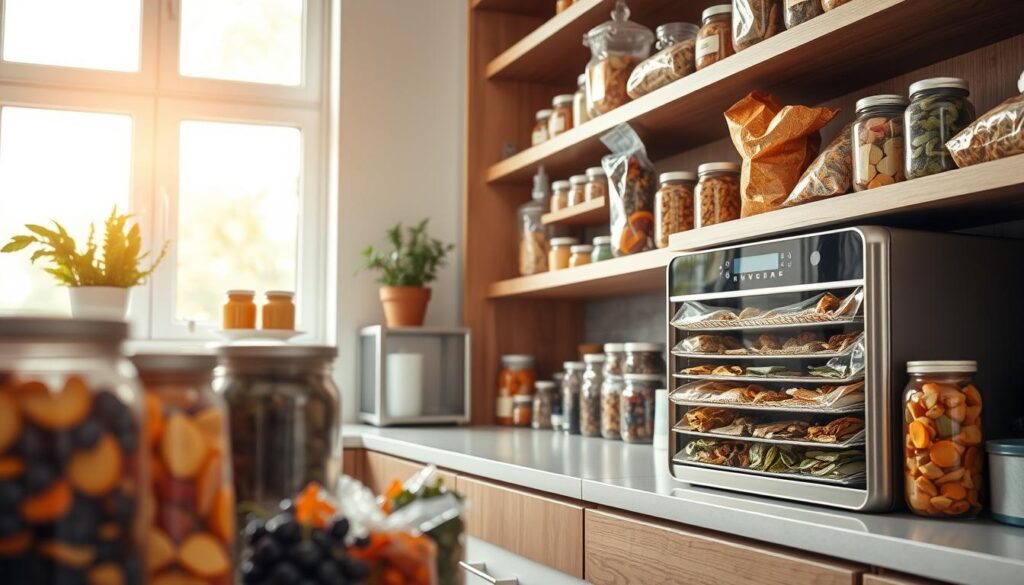Table of Contents
I’m excited to share the world of dehydrator recipes with you. Here, you can explore new flavors and textures by drying your favorite foods. Dehydrating food keeps nutrients fresh and makes healthy, tasty snacks and meals.
With dehydrator recipes, enjoy your favorite foods all year. Try everything from sweet fruit leathers to savory beef jerky. Making these recipes is fun and easy, perfect for any kitchen skill level.
Exploring dehydrator recipes opens up a world of dishes. From snacks to meals, there’s something for everyone. This article will cover the basics of dehydration, the benefits of homemade foods, and delicious recipes for fruits, veggies, meats, and more.
Introduction to Dehydrator Recipes
Dehydrator recipes are a healthy snack option. They let you control what goes into your food, avoiding excess sugar and salt. Plus, you can tailor recipes to your taste, making them great for dietary needs.
Key Takeaways
- Dehydrator recipes are a great way to preserve nutrients and create healthy snacks
- Easy dehydrator recipes are perfect for beginners and experienced cooks alike
- Homemade dehydrator recipes offer a fun, creative way to experiment with new flavors and ingredients
- Dehydrator recipes can be customized to suit your dietary needs and preferences
- Dehydrator recipes are a healthy alternative to store-bought snacks
- Dehydrator recipes can be used to make a variety of dishes, from snacks to meals
Getting Started with Food Dehydration: Essential Equipment and Tips
Starting with food dehydration, I see that the right equipment is key. There are many dehydrators out there, and I need to think about my budget, space, and what I want to dehydrate. I’m searching for healthy dehydrator recipes that are simple and don’t need much gear.
Temperature control is crucial in dehydrator recipes. Different foods need different temperatures to dry right without getting too dry. For instance, fruits and veggies can dry at lower temps, while meats need higher ones. I’ve found that raw dehydrator recipes keep the natural taste and nutrients of my favorite foods best.
Here are some key tips for beginners:
- Choose a dehydrator that fits your budget and space
- Understand basic temperature guidelines for different foods
- Experiment with pre-treatment methods like blanching or marinating to enhance flavor and texture
By following these tips and trying out different dehydrator recipes, I’m sure I can make tasty and healthy snacks for myself and my family. Whether I’m making raw dehydrator recipes or trying new flavors, my dehydrator will be a great addition to my kitchen.
Benefits of Making Your Own Dehydrated Foods
Making your own dehydrated foods has many benefits. It’s good for your health, saves money, and is convenient. By using healthy dehydrator recipes at home, you can choose what goes into your snacks. This way, you ensure they are tasty and full of nutrients.
Homemade dehydrated snacks keep more nutrients than canned or frozen ones. The dehydration process saves the natural goodness of the ingredients. Plus, you avoid preservatives, added sugars, and too much salt. This makes them a better choice for you and your family.
Some key benefits of making your own dehydrated foods include:
- Cost-effectiveness: Buying ingredients in bulk and dehydrating them at home can save you money in the long run.
- Customization: You can create healthy dehydrator recipes tailored to your taste preferences and dietary needs.
- Convenience: Homemade dehydrated snacks are perfect for on-the-go, and they can be easily stored for later use.
Exploring dehydrated foods can be rewarding. Making your own homemade dehydrator recipes is easy and fun. With the right tools and a bit of practice, you can make tasty and healthy snacks. These snacks will satisfy your cravings and help keep you healthy.
Fruit Dehydrator Recipes for Sweet, Healthy Snacks
Dehydrating fruits is a great way to enjoy your favorite snacks while staying healthy. With many fruit dehydrator recipes out there, you can make tasty and nutritious treats. You can make everything from sweet and tangy to crunchy and chewy snacks.
Fruits are perfect for healthy dehydrator recipes. They are naturally sweet and keep their nutrients and flavor when dehydrated. You can dehydrate apples, bananas, and berries. Or try mixing different fruits for new and exciting flavors.
Here are some tips for making the most of your fruit dehydrator recipes:
- Choose fresh and ripe fruits for the best flavor and texture
- Experiment with different seasonings and spices to add flavor to your dehydrated fruits
- Store your dehydrated fruits in airtight containers to preserve their freshness and crunch
With these tips and a little creativity, you can make a variety of delicious and healthy dehydrator recipes with your favorite fruits. Whether you need a quick snack or a healthy treat to take with you, dehydrated fruits are a great option.
Vegetable Dehydrating Techniques and Recipes

I’m excited to share my findings on vegetable dehydrator recipes. Dehydrating vegetables helps keep their nutrients and flavors. It’s easy to do with a little practice. You can make delicious, healthy snacks with these recipes.
Raw dehydrator recipes are great because they keep enzymes and vitamins in vegetables. Leafy greens like kale and spinach are full of nutrients. You can make crispy kale chips that are tasty and good for you.
Some popular vegetable dehydrator recipes include:
- Beet jerky: a sweet and savory snack made from dehydrated beets
- Carrot sticks: crispy and flavorful, perfect for dipping in hummus
- Broccoli bites: a healthy and tasty snack made from dehydrated broccoli
When dehydrating vegetables, the right temperature and time are key. Each vegetable needs different settings. With patience and practice, you can make many delicious vegetable dehydrator recipes.
Creating Perfect Beef Jerky in Your Dehydrator
Making delicious beef jerky is all about finding the right mix of flavors and textures. With the right jerky dehydrator recipes, you can make a tasty, healthy snack for when you’re on the move. Choosing the right marinade is crucial. A good marinade adds depth and tenderness to your jerky.
Popular marinades for beef jerky include soy sauce, garlic, and ginger. You can also add brown sugar, smoked paprika, or chili flakes for a unique taste. Beef jerky is a great choice for easy dehydrator recipes because it’s simple and needs just a few ingredients. Here are some tips for making beef jerky:
- Always use high-quality ingredients, including fresh meat and spices.
- Make sure to slice the meat thinly and evenly, so that it dries consistently.
- Use a food dehydrator to dry the meat, as this will help to preserve the flavors and textures.
By following these tips and using the right jerky dehydrator recipes, you can make delicious, healthy beef jerky. It’s perfect for snacking. Whether you’re looking for a quick and
Raw Food Dehydrator Recipes for Health Enthusiasts
I’m always searching for ways to eat more raw foods. Using a dehydrator is a great way to do this. It helps me make healthy, easy-to-digest foods that are full of enzymes.
Some of my top picks for raw dehydrator recipes include:
- Crispy kale chips made with fresh kale, olive oil, and sea salt
- Raw crackers and breads made with nuts, seeds, and dried fruits
- Dehydrated energy bars made with dates, nuts, and coconut flakes
These recipes are not just tasty; they’re also full of nutrients. And the best part? I can make them at home. This way, I can enjoy raw foods all year long.
With a bit of creativity, you can make endless raw food dehydrator recipes. Whether you’re new to health foods or a seasoned pro, I invite you to try these recipes. Discover the amazing benefits of raw foods for yourself.
| Recipe | Ingredients | Dehydrator Time |
|---|---|---|
| Crispy Kale Chips | Fresh kale, olive oil, sea salt | 2-3 hours |
| Raw Crackers and Breads | Nuts, seeds, dried fruits | 4-6 hours |
| Dehydrated Energy Bars | Dates, nuts, coconut flakes | 6-8 hours |
Herb and Spice Drying Guide
Drying herbs and spices is a great way to keep them for later. A dehydrator makes it easy to dry herbs like basil and rosemary. You can also dry spices like cinnamon and turmeric, keeping their flavor and smell.
To start, rinse your herbs and spices with water. Then, dry them with a paper towel. Put them in your dehydrator and set the temperature as the manual says. Usually, herbs and spices need a temperature of 95-105°F (35-40°C).
Here are some homemade dehydrator recipes for drying herbs and spices:
- Drying basil for pesto and Italian dishes
- Drying rosemary for soups and roasted meats
- Drying cinnamon for baked goods and desserts
By following these steps and using your dehydrator, you can make your own homemade dehydrator recipes. This saves money and lets you enjoy your favorite herbs and spices all year.
Storage Solutions and Shelf Life for Dehydrated Foods

Proper storage is key for keeping dehydrated foods fresh. After making tasty dehydrated snacks, it’s important to store them right. This keeps their taste, texture, and nutrients intact. We’ll look at the best ways to store dehydrated foods and how long they last.
Use airtight containers or vacuum-sealed bags to keep foods fresh. These stop moisture, light, and air from getting in. This helps prevent your snacks from getting stale or tasting bad. Glass jars, plastic containers, and vacuum-sealed bags are good choices.
Humidity and temperature also affect how long dehydrated foods last. Store them in a cool, dry spot, away from sunlight and heat. Following these tips helps you enjoy your dehydrator recipes longer and keeps them safe to eat.
- Store dehydrated foods in airtight containers or vacuum-sealed bags
- Keep them in a cool, dry place, away from direct sunlight and heat sources
- Check for signs of spoilage, such as mold, sliminess, or off-odors
By using these storage tips and knowing what affects shelf life, you can enjoy your dehydrator recipes longer. Always check your stored foods for spoilage before eating. If they’re bad, throw them away.
Conclusion: Making the Most of Your Food Dehydrator
As we wrap up our exploration of dehydrator recipes, I’m thrilled to encourage you to start dehydrating your favorite foods. Whether you’re after healthy snacks, ways to keep seasonal produce fresh, or a new cooking adventure, a food dehydrator is a great addition to your kitchen.
A dehydrator is easy to use and versatile. It lets you make a variety of tasty and healthy foods. Think about turning fresh fruits and veggies into tasty, long-lasting snacks or making your own beef jerky. The possibilities are endless.
So, start trying out new dehydrator recipes and enjoy your food dehydrator. It’s convenient, healthy, and fun to make your own, preservative-free treats. Your taste buds and wallet will appreciate it.

